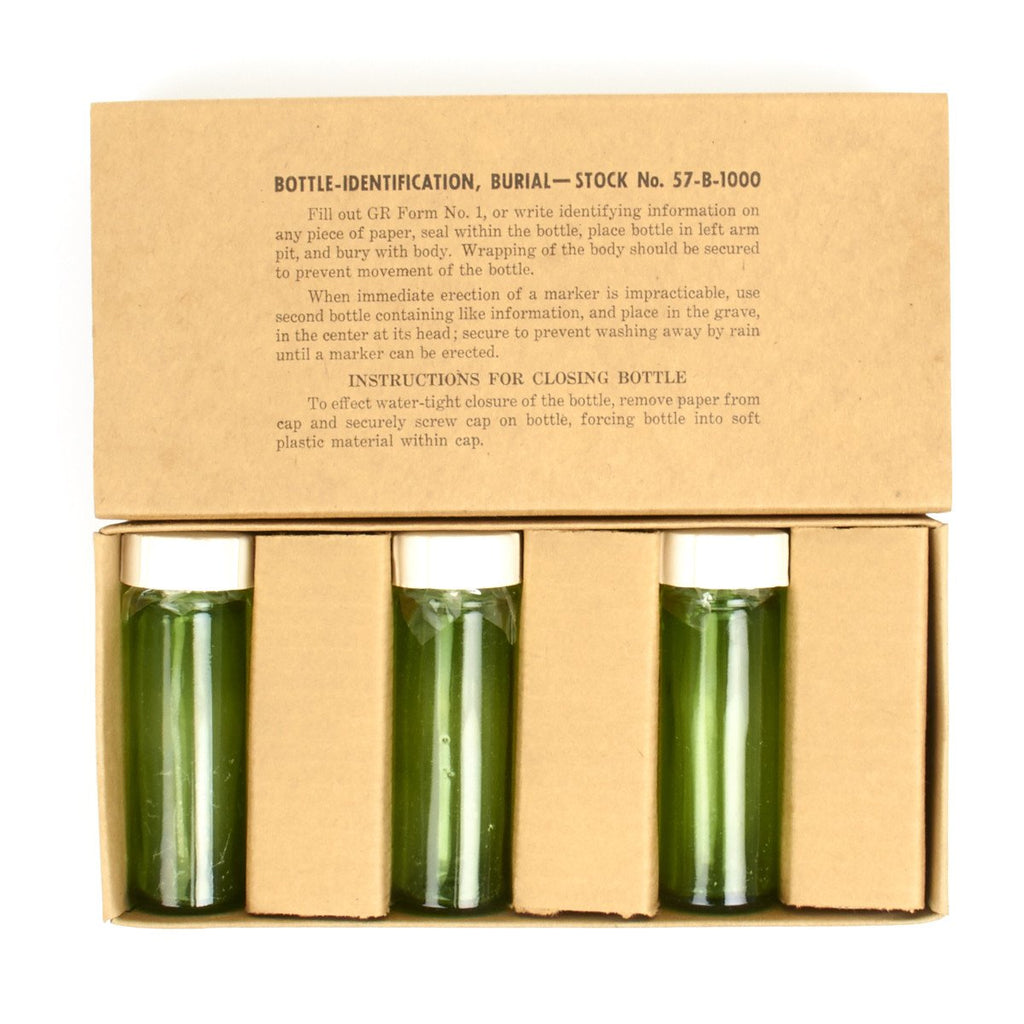Item Description
Original Item: Fascinating set of unopened unissued burial bottles from World War Two issued by the Graves Registration Service. The official designation is BOTTLE-IDENTIFICATION, BURIAL - STOCK NO. 57-B-1000.
The box slides open to show six NOS (New Old Stock) burial bottles, green glass construction, with ceramic white tops and a protective shield.
Cardboard package measures approximately 4.25 x 9 inches. Due to long storage these boxes may be slightly dented or deformed, as the crates they came from were not always handled gently. However the bottles will all be intact.
Bottles measure approximately 4 inches tall.
Perfect for the WW2 USMC US ARMY DOG TAG collector who thought they had everything!
Very uncommon unused set of BURIAL IDENTIFICATION BOTTLES used US Medical Corps QUARTERMASTER GRAVES REGISTRATION SERVICES (USMC US ARMY).
Printed instructions on box lid explain the proper usage:
BOTTLE-IDENTIFICATION, BURIAL - STOCK No. 57-B-1000
Fill out GR Form No. 1, or write identifying information on any piece of paper, seal within the bottle, place bottle in left arm pit, and bury with body. Wrapping of the body should be secured to prevent movement of the bottle
When immediate erection of a marker is impracticable, use second bottle containing like information, and place in the grave, in the center at its head; secure to prevent washing away by rain until a marker can be erected.
To effect water-tight closure of the bottle, remove paper from cap and securely screw cap on bottle, forcing bottle into soft plastic material within cap.
A rubber/plastic gasket lid was to weatherproof seal the contents. The green tint color was a sun resistant barrier to prevent the sunlight from fading out GR-1 FORM paper information should it be unearthed.
Genuine wartime issue implemented late war by the time of D-DAY and should dispel the 'GI myth' that the M-1939 & M-1940 dog tags' notch was used to wedge into the KIA's front teeth (the notch was to align the tag on the series 300 ADDRESSOGRAPH machine). In the pre-DNA era, dental records were an important means of identification so to have purposely mangled, distorted teeth would render the QM GRS job that much more difficult.
More background Information:
The care of deceased military personnel and the maintenance and supervision of National Cemeteries are among some of the special services entrusted to The Quartermaster General. In 1861 the Secretary of War ordered The Quartermaster General to provide forms for preserving burial records and materials for registered headboards to be placed at the heads of all fallen soldiers' graves. In 1876 the Secretary of War formally charged The Quartermaster General with the responsibility of supervising the National Cemetery system, and centralizing all Mortuary Records. The way was further paved for a Theater Graves Registration Service during WW1, when The Quartermaster General was now responsible for the care of the dead and charged with the preservation of Mortuary Records as well as the maintenance of Temporary Burials and Semipermanent Military Cemeteries.
The outbreak of WW2, brought about a complete reorganization of the War Department. Fighting forces in 1942 and early 1943 were obliged to improvise their own Graves Registration Service, and tactical units were responsible for collecting and burying their own dead. Between March 28 and December 2, 1943 - thirteen GRS Companies were activated. Tactics and doctrine, as well as training were not yet available; the first document to be used as a basis was T/O 10-297 dated 1 November 1940, and another tool became TM 10-630 dated 23 September 1941. T was a strong need for simplification and reorganization, and finally The Quartermaster General was designated Chief, American Graves Registration Service by War Department Circular 206, dated 11 September 1943, making him responsible for formulating policies for the operation of Graves Registration Services outside the continental United States. In the field, Tunisia helped gain experience by trial and error, and the first official Theater Graves Registration Service was announced on 1 April 1943. Sicily was already better organized, while the first efficient recovery and evacuation of American dead took place during the Italian Campaign. On 9 June 1944, General Dwight D. Eisenhower finally signed Standing Operating Procedure No. 26 governing Army Burials, Graves Registration and Disposition of Effects, effective in the European Theater of Operations.
Find more information here-
http://www.med-dept.com/articles/quartermaster-graves-registration-service
- This product is available for international shipping.
- Eligible for all payments - Visa, Mastercard, Discover, AMEX, Paypal & Sezzle














